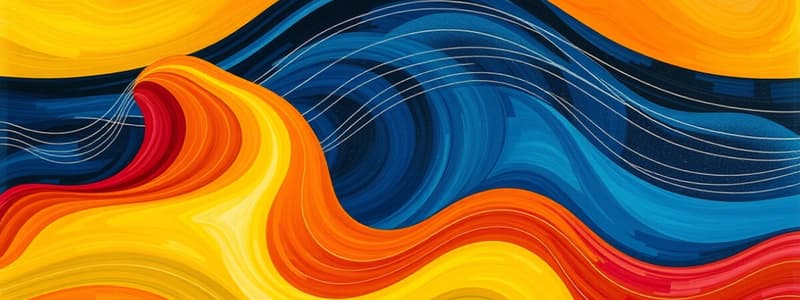Podcast
Questions and Answers
What defines energy in a physical context?
What defines energy in a physical context?
- The quantity of matter in an object
- The ability to do work (correct)
- The speed of particles in a medium
- The sum of kinetic and potential energy
In which type of wave do particles vibrate in a direction parallel to the wave's movement?
In which type of wave do particles vibrate in a direction parallel to the wave's movement?
- Transverse waves
- Longitudinal waves (correct)
- Seismic waves
- Surface waves
What is the term for the distance from one crest to the next in a transverse wave?
What is the term for the distance from one crest to the next in a transverse wave?
- Frequency
- Velocity
- Wavelength (correct)
- Amplitude
Which measurement corresponds to the number of crests passing a point in a second?
Which measurement corresponds to the number of crests passing a point in a second?
What characterizes a rarefaction in a longitudinal wave?
What characterizes a rarefaction in a longitudinal wave?
Why do sound waves travel fastest through solids compared to gases?
Why do sound waves travel fastest through solids compared to gases?
What is the relationship described by the wave equation?
What is the relationship described by the wave equation?
Which of the following statements is true regarding ocean surface waves?
Which of the following statements is true regarding ocean surface waves?
Flashcards are hidden until you start studying
Study Notes
Energy and Matter
- Energy is defined as the ability to perform work.
- Matter is anything that has mass and occupies space.
Mechanical Waves
- Mechanical waves are disturbances that transmit energy through matter.
- Ripples and waves in water exemplify energy transmission in liquids.
- Sound waves propagate through gases, specifically the air.
- Seismic and sound waves can travel through solids, such as Earth's crust.
- Sound waves travel fastest in solids due to closely packed particles and stronger inter-particle bonds.
Wave Types
- Transverse waves involve particles that vibrate perpendicular to the wave's direction of travel.
- Longitudinal waves have particles vibrating parallel to the wave's direction of movement.
Wave Characteristics
- Wavelength (measured in meters, centimeters, millimeters, or nanometers) is the distance between successive crests in a transverse wave.
- Amplitude represents the height from the midpoint to a crest or trough; it indicates wave energy—the greater the amplitude, the more energy the wave carries.
- Frequency (measured in Hertz, Hz) is the number of crests that pass a specific point per second (e.g., three crests per second).
Wave Equation
- The relationship between wave velocity, wavelength, and frequency is expressed in the wave equation: velocity = wavelength × frequency.
- Velocity is measured in meters per second.
Longitudinal Wave Anatomy
- Longitudinal waves consist of rarefaction (low pressure areas where particles spread apart) and compression (high pressure areas where particles are closely packed).
- Wavelength in longitudinal waves is measured from the end of one compression to the end of the next compression or from one rarefaction to the next.
- Amplitude in a longitudinal wave is determined by the pressure difference between rarefaction and compression.
Sound Wave Mechanics
- In sound waves, particles intermittently bunch together and disperse as sound energy travels through matter.
Surface Waves
- Surface waves, another type of mechanical wave, occur in water where particles move in both parallel and perpendicular directions in circular motion.
- Ocean waves are categorized as surface waves.
Studying That Suits You
Use AI to generate personalized quizzes and flashcards to suit your learning preferences.




